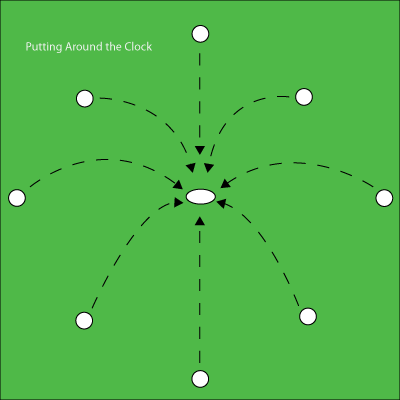While correctly judging the speed of your putts is the most important factor in avoiding three putts, correctly determining the break of your putts is crucial to making more putts. Scratch and low handicap golfers rely on making putts to score low. High handicap golfers are too inconsistent to score low, but making putts can offset other miscues and help in shooting 90. Strokes with your putter make up a bigger part of your score than any other club. Knowing how to judge the break of your putts is necessary for sinking more putts.
The first key to making more putts is to know the speed of the greens. Visit the practice green before your round. Hopefully it is a similar speed to the course greens. Take a couple balls and putt from 5, 10 and 15 feet. Finally putt to a few different spots on the edge of the fringe. Putting to the fringe is a great way to confirm you have a good idea of the speed of the green.
It is also important to know the overall terrain of the golf course. If there are mountains nearby, every green will most likely slope away from them. Likewise, the greens will most likely slope towards the lowest point in the area. The greens on most courses will slope down from the back to the front. As you walk up to each green on the course, use this knowledge to examine your upcoming putt. Based on where your ball is sitting on the green, determine if your putt will be uphill or downhill and which general direction it will break.
When on the green, you will want to look at your putt from multiple views. The first thing you need to verify if your ball is above or below the hole. The easiest way to do this is to look at both your ball and the hole from a side view. Knowing whether your putt is uphill or downhill is important for both judging the speed and break. The best view to read the break of a putt is from below the hole. So for an uphill putt, you should view the putt from behind the ball looking up to the hole. Conversely, for a downhill putt, view the putt from behind the hole looking up to the ball. If you have the time, look at the putt from above the hole. Having multiple looks at your putt will give you more information and will help your decision making. Crouch down and be as low to the green as possible when viewing your putts.
When lining up your putts, you are visualizing the path your ball will take going in the hole. The curve(s) of this path is determined by many factors including whether the putt is uphill or downhill, the slope of the green and the speed of the green.
The ball will break more or less depending on how fast it is going. A slower moving ball will break more than a faster moving ball. This is because gravity has a greater affect on an object the slower it goes.
It is important to recognize circumstances where your ball will be travelling more slowly and taking more break such as:
Downhill Putts – You hit your ball more slowly on a downhill putt as it needs less speed to make it to the hole.
Fast Greens – The ball needs less speed to reach the hole on a fast green.
When Approaching the Hole – As your ball approaches the hole, it loses speed thus being affected more by the slope of the green. Conversely, your ball will take less break after it is first hit.
Probably the hardest part of a putt with a lot of break is getting the ball rolling on your visualized path with the right speed to keep it on the path. This is where a lot of the “feel” you here about in putting comes into play. Knowing the right direction and speed for a putt to get it on your visualized path largely comes down to practice and experience. One tip is to putt “around the clock” during a practice session on the practice putting green. Find a hole on a slope and putt balls from 12 o’clock all the way around back to 12 o’clock. This repetition will help you hole more putts from these same positions during play.

Putting is the key for both the professional and high handicap golfer working on shooting 90. Practice reading and making putts with break and you will find yourself sinking more on the course.


2 replies on “Reading Putts”
Hi Dick,
It’s best to view your putt from below the hole. View from both ways if you have time.
Is it best to approach the hole below or above a sloping hole?